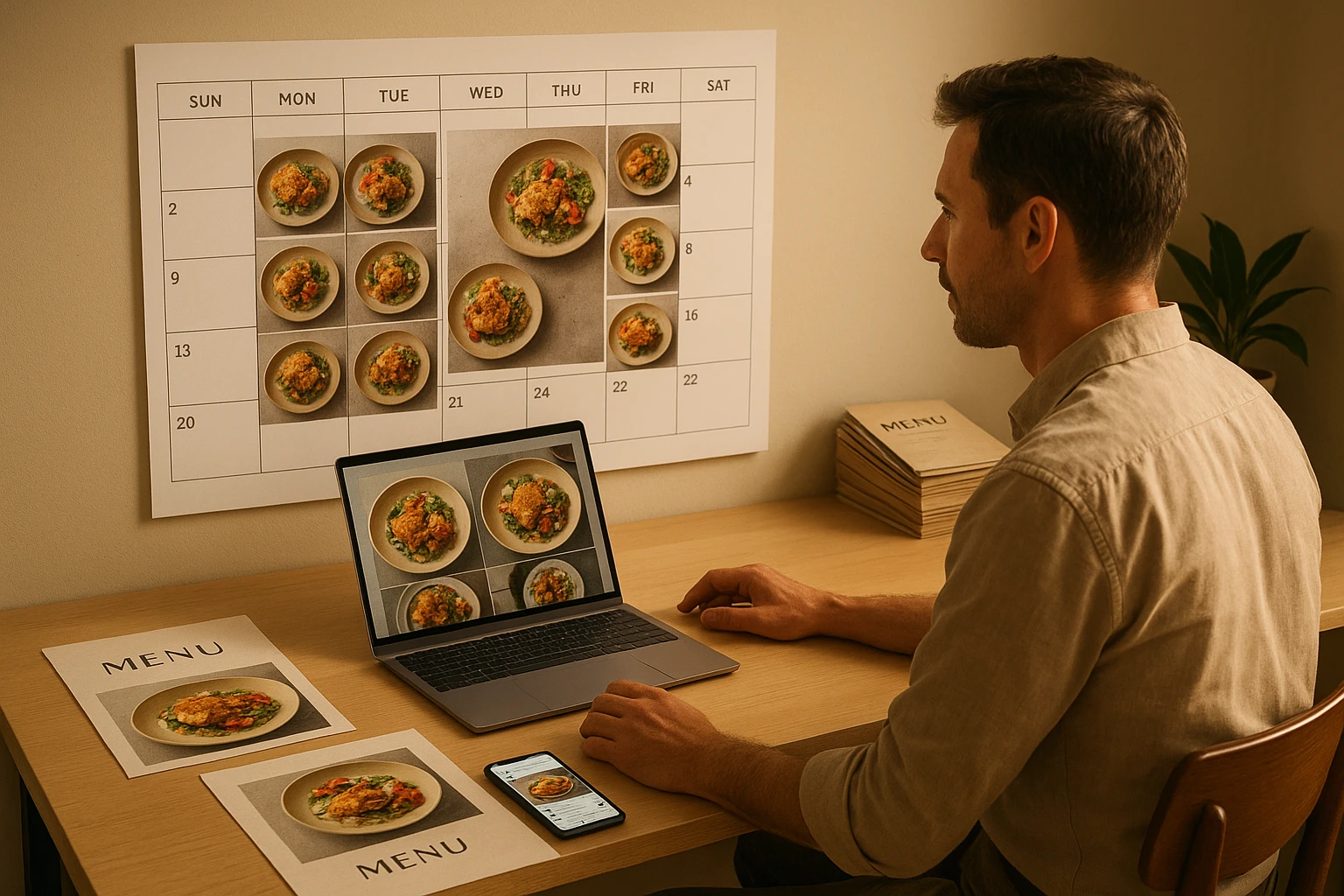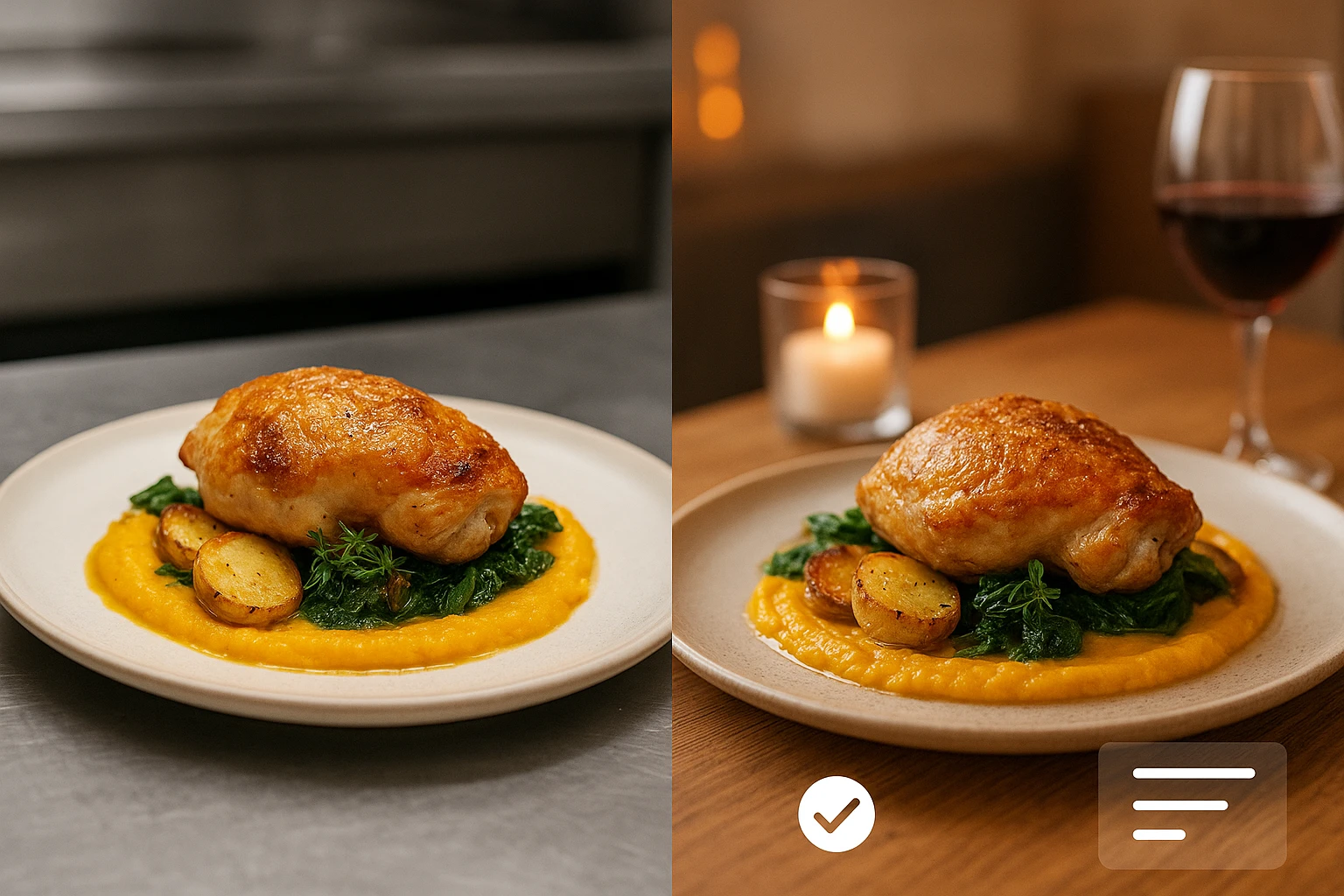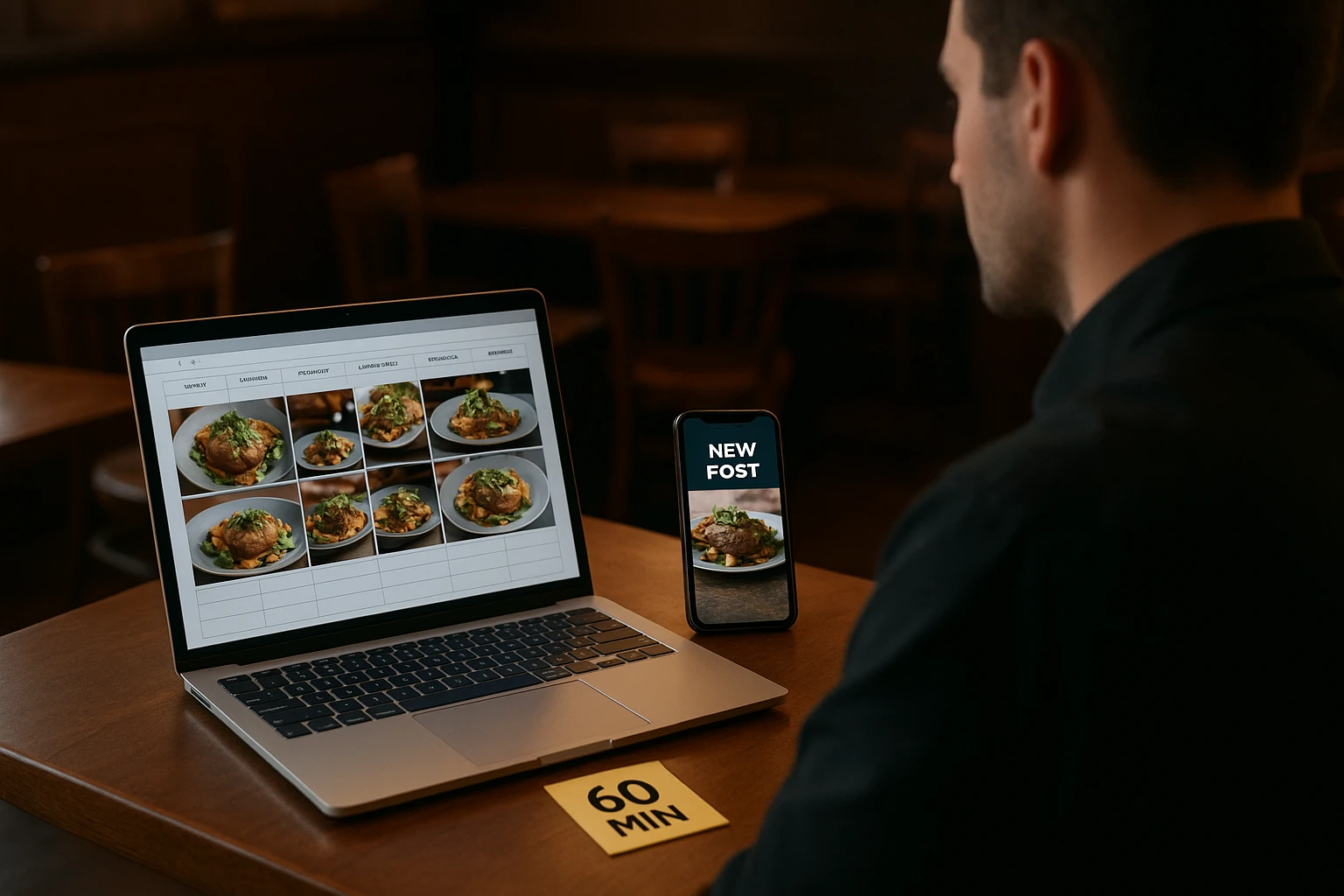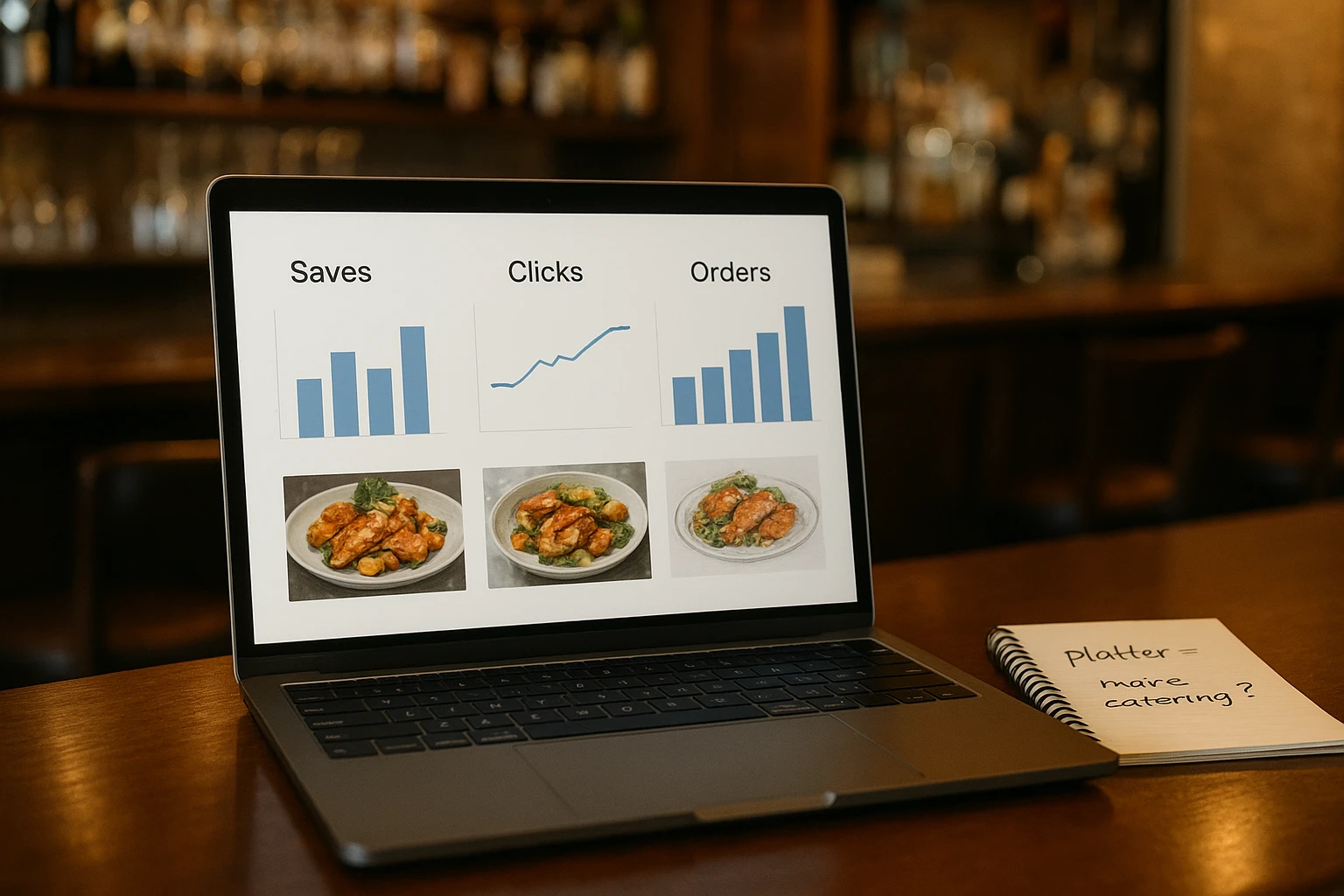One Dish, 10 Posts: AI Variations That Fill Your Calendar

Quick navigation:
1. Why one dish can power a month of AI content
One Dish, 10 Posts: Operator Cheat Sheet
| Decision | Recommended Choice |
|---|---|
| Primary keyword focus | AI food content calendar |
| Ideal base dish to start with | Your top-selling, visually distinct item (e.g., loaded fries, signature bowl, hero pizza) |
| Target time to create 10 posts | 45-60 minutes using AI-assisted workflows |
| Core channels to prioritize | Instagram Reels + Stories, TikTok, QR menu hero image, Google Business Profile, email header |
| Review cadence | Monthly: refresh with seasonal twist on the same hero dish |
It’s a Tuesday lull between lunch and dinner. Your best-selling mac and cheese is still steaming on the line. You know that one dish could be the star of Instagram, your QR menu, and next week’s catering email-but you’ll be back on the expo line in 10 minutes, so the idea dies there.
Meanwhile, guests are opening your profiles daily to decide where to eat, and competitors are filling their feeds with AI-polished food photos. According to Gartner, marketing teams using generative AI are already multiplying content output without multiplying staff. Independent operators and small groups need the same edge-but without new headcount or $3,000 photo shoots.
Find your true hero dish
Instead of trying to photograph your entire menu, you start with one “hero dish” that can pull its weight all month.
Use three questions:
- Sales: What are your top 1-2 items by revenue over the last 90 days?
- Visual: Which of those looks distinct at a glance (color, layers, toppings)?
- Strategic role: Which one supports your biggest goal right now-delivery tickets, catering trays, or dine-in checks?
For a taco shop, this might be a stacked birria taco plate with consomme. For a salad concept, it could be a rainbow grain bowl.
Why one dish is enough with AI
In a traditional workflow, that birria plate would get 1-2 photos at most. With an AI food photography workflow like Yummify’s, one honest base photo can become:
- A tight cheese-pull close-up for Instagram.
- A wider overhead shot for the QR menu.
- A family-style platter variation to hint at catering.
- A takeout-focused angle with branded packaging for your Google Business Profile.
You’re not inventing new dishes-you’re reusing the same star in 10 roles.
According to the National Restaurant Association’s State of the Restaurant Industry 2024 report, operators cite marketing and staffing as two major ongoing pressures. An AI-assisted system eases both: one person with a smartphone can produce enough honest visuals for weeks.
How Yummify fits in
A realistic monthly flow:
- You or a cook snap 5-10 iPhone shots of the hero dish in good light on the pass.
- You upload the best angle into Yummify, pick a saved branded environment (for example, “Neon Taqueria” or “Cozy Brunch Cafe”), and generate several styled images.
- You selectively upgrade quality only on the variations you’ll feature on menus or paid placements.
You’ve just replaced a full-afternoon shoot with a 15?minute task that still looks on-brand.
Clarify which dish is your real hero-write it down before you move on to the workflow sections.

2. From one plate to 10 posts: channel-first planning
Most teams open an AI tool and start experimenting. That’s how you end up with pretty images that don’t actually help orders. The smarter path is channel-first planning-you decide the jobs your hero dish will do before touching prompts.
Decide what each channel is responsible for
Here’s a simple set of roles you can adapt:
- Instagram Reels / TikTok: Reach new locals and make them crave the dish.
- Instagram feed: Save-worthy hero shots guests show friends.
- Stories: Quick “today only” promos or low-effort reminders.
- QR menu / ordering app: Clear, honest visuals that speed decisions.
- Google Business Profile: A single photo that proves “this is worth getting in the car for.”
- Email header: Wider shots that sell catering, family meals, or events.
Meta’s guidance on Reels recommends vertical, movement-forward content-so your AI variations there might focus on steam, pours, or cheese pulls. In contrast, a QR menu image needs a calm, overhead view with no distractions.
Map “one dish, 10 posts”
Use this as a starting grid and customize it for your concept:
| Post # | Angle | Primary channel | Goal |
|---|---|---|---|
| 1 | Melty hero close-up | Instagram feed | Saves and shares |
| 2 | Quick prep montage (AI-styled from base stills) | Reels | Reach new diners |
| 3 | Family-style spread with sides | Email header | Group dining & catering |
| 4 | Clean overhead menu shot | QR menu | Faster table decisions |
| 5 | Simple plate with “GF/V” sign in caption, not image | Website menu | Dietary trust |
| 6 | “Tonight only” crop with price added in design tool | Stories | Move inventory |
| 7 | Takeout container focus | Google profile | Promote pickup/delivery |
| 8 | Seasonal garnish twist (pumpkin seeds, herbs) | Reels/TikTok | Stay on trend |
| 9 | UGC-inspired table scene | Instagram feed | Show social proof |
| 10 | Reheat/leftover visual | Post-purchase email | Reduce complaints |
Link ideas like #9 to a fuller UGC + AI workflow when you’re ready to remix guest photos ethically.
Two realism levels: strict vs flexible
Not every surface needs the same level of realism:
- Strict realism: QR menus, allergen/dietary pages, third-party delivery apps. Here, AI can tidy background and lighting but should not alter ingredients, portions, or vessels.
- Flexible realism: Reels covers, Stories, and some email headers. Here, it’s fine to shift the table setting, add props, or warm up lighting, as long as the dish itself still reflects what guests receive.
For QR and ordering flows, see the deeper tactics in QR menu best practices.
Sketch your own 10-post grid on paper or a notes app, matching each idea to a primary channel before you touch any AI tools.

3. Honest AI variations: prompts, guardrails, and Yummify workflows
AI is powerful enough to quietly change your gluten-free pasta into regular penne or add nuts where there were none. That’s exactly what you must prevent. Guests already navigate allergens and dietary needs under stress; your visuals cannot add risk.
The State of the Restaurant Industry 2024 report notes that guests are paying closer attention to health, wellness, and dietary transparency than before the pandemic, while operators juggle more off-premise channels than ever (National Restaurant Association). That makes honest imagery a trust issue, not just a creative one.
Start from one honest base photo
Whether you upload a reference into Yummify or describe the dish with text, establish a baseline:
- Plate the dish exactly as served-same portion, garnishes, and vessel.
- Shoot in daylight near a window, avoiding harsh overheads.
- Capture a few angles: overhead, 45-degree, and a tight detail.
Yummify validates that uploads are food before transforming them, which helps keep outputs closer to reality.
Write prompts that change mood, not ingredients
A simple, reusable prompt outline:
“Well-lit [cuisine] [dish] on [type of plate] with the same ingredients and portion as reference, shot at [angle]. Change only the background to a [environment description] and adjust lighting to feel [mood]. No extra toppings or ingredients. No change in portion size.”
Then add negative prompts for your red-list items, for example:
- “No nuts or seeds.”
- “No cheese or dairy.”
- “No change to gluten-free pasta.”
For a deeper framework, see the checklist in honest imagery for allergens and dietary claims.
A lightweight review checklist
Use this 6-point check before any AI image hits menus or ads:
- Compare side-by-side with the real dish on the pass.
- Confirm portion size, plate, and key garnishes match service.
- Check allergen and dietary claims: nothing added that could mislead.
- Reject any unrealistic drips, impossible cheese pulls, or extra ingredients.
- Decide where this variation is allowed (social only vs menus/QR vs delivery apps).
- Log who approved it and when.
Assign one person-often the GM or marketer-as the final approver.
Define your own non-negotiables for AI images-ingredients, portions, and dietary claims that can never be altered.

4. Batching the workflow: 60 minutes to a filled calendar
Once you’ve chosen a hero dish and guardrails, the real win is turning this into a monthly habit. Think of it as a content kitchen: one focused hour where you prep, “cook,” and plate a full AI food content calendar.
60-minute batch workflow
Use this structure (adapt the exact minutes to your reality):
- Prep (0-10 min): Confirm this month’s hero dish, pull last month’s notes on which angles performed best, and review your non-negotiables.
- Capture (10-20 min): Plate the dish once, shoot 5-10 photos in natural light (and a quick 10-second video if you can).
- Generate (20-40 min): Upload your best base image into Yummify, select a saved branded environment, and generate 10-15 variations focused on background, angle, and mood.
- Format (40-50 min): Export the strongest images and drop them into pre-sized templates for Reels covers, Stories, QR heroes, and email headers in a design tool like Canva.
- Schedule (50-60 min): Load finished assets into your social scheduler, website, or QR menu system, labeling each by dish and angle.
This mirrors the kind of repurposing flow Content Marketing Institute outlines for written content, applied to visuals.
Using a design layer on top of Yummify
Yummify gives you the styled food asset; a design app lets you resize and add light branding. This short video shows a similar idea-using AI inside a design tool to tweak and resize visuals for different platforms:
You can follow the same pattern:
- Use Yummify to generate honest, on-brand dish variations.
- Bring them into a design tool only to crop, resize, and add light overlays like your logo or a price badge.
For multi-unit groups, create a shared folder per hero dish with clear names like mac-cheese_feed-closeup_v1 or mac-cheese_QR-overhead_v2 so any new marketer can find the right files in seconds. When you expand to trays or buffets, the same system scales-see AI-styled catering platters for platter-specific tips.
Pick a recurring 60-minute slot on your calendar for a monthly “content kitchen” and invite whoever currently handles your social posts.

5. Measuring what matters: turning variations into revenue
Once your AI food content calendar is running, the question becomes: are these variations leading to more orders, or just more likes? You don’t need a data team-just clarity on what each angle is supposed to do.
Match angles to outcomes
Start with a tiny scorecard for your hero dish. Example:
| Angle | Primary use | Key metric | Result notes |
|---|---|---|---|
| Hero melty close-up | Instagram feed | Saves & shares | Track if saves increase week over week. |
| Family-style platter | Catering page/email | Catering inquiries | Note spikes after sends. |
| Clean overhead | QR menu | Time-to-order (observed) | Servers report fewer “what is this?” questions. |
| Packaging focus | Google profile | Calls & direction taps | Watch for small bumps after swapping photo. |
| Dietary/allergen highlight | Website menu | Time on page & complaints | Fewer surprise-allergen complaints is a win. |
You can log this in a simple spreadsheet once a week. As HubSpot’s marketing trends report points out, marketers increasingly prioritize data that ties to pipeline and revenue over vanity metrics; operators can steal that mindset in a lighter form.
Run small, focused tests
A few realistic experiments:
- QR menu hero swap: Use a clean overhead variation for two weeks, then a slightly wider contextual shot for two weeks. Ask servers which period had fewer clarifying questions and watch add-on rates for sides or drinks.
- Google Business photo test: Rotate between a dine-in hero and a packaging-focused shot. Over a month, look for changes in “Call” and “Directions” taps in your Google dashboard.
- Catering email angle test: One send uses a tight close-up; the next features a table-length platter (built via AI from your hero dish). Compare which email leads to more catering form fills.
Over 2-3 months you’ll identify repeat winners-the melty close-up that always gets saves, the platter that consistently sparks catering queries. Lock these into your Yummify presets and prompts so each new batch starts from what actually works.
Choose one metric you can start tracking this week for your hero dish visuals-saves, clicks, QR scans, or catering inquiries-and log it in a simple spreadsheet.

Next steps
If you’ve identified your hero dish and sketched a 10-post grid, you’re halfway to an AI-powered content system. The next step is giving yourself better raw material.
Take one honest smartphone photo of that dish this week and upload it into Yummify. Build a simple branded environment that matches your dining room, generate a handful of safe variations, and drop the best into your social or QR menu. Once you see how fast that one dish can fill your calendar, you can repeat the process for your top seasonal or catering items without adding a single extra shoot day.
FAQ
Can I really rely on AI-created variations of my dishes without misleading guests?
Yes-if you anchor every variation to an honest base and set clear guardrails. Start with a real photo that matches your true portion, vessel, and garnishes, then use AI only to adjust background, lighting, and angle. Never add or remove allergens or dietary signals in the image; if a dish is nut-free or gluten-free, your AI styling should preserve that. Build a short approval checklist and have one person compare AI outputs to the real dish before they appear on menus or ads. For a deeper framework, see the guidance in Honest Imagery for Allergens and Dietary Claims.
How often should I rotate my hero dish in this one dish, 10 posts workflow?
For most restaurants, monthly works well: keep a single hero dish for 4-5 weeks, then refresh with a seasonal twist or a new item. The 2024 State of the Restaurant Industry report highlights how menus and guest expectations are shifting faster than before, especially with more off-premise occasions (National Restaurant Association). Rotating monthly balances consistency (guests recognize your signature item) with freshness for returning followers. In shoulder seasons or slower months, you might keep an all-weather hero like a burger or bowl for longer and just update garnishes. Track performance: if a hero dish stops getting saves, clicks, or QR scans, it’s time to swap.
What if my best-selling dish isn’t very photogenic-can this still work?
Yes, but you may need to adjust what you treat as the “hero.” If your top seller is visually flat, like brown stews or certain curries, consider featuring a combo plate, side spread, or bread pairing that includes the hero rather than the bowl alone. You can also lean on angle and garnish-overhead shots, fresh herbs, or contrasting plates-to create more structure and color, as covered in Culinary Nuance: AI Styling Techniques by Cuisine. Another option is to pick your most visually distinct high-margin item as the hero, even if it’s your #2 or #3 seller. The goal is to get people onto your menu; once they’re there, they’ll often discover and order the “ugly” but delicious dishes too.
How do I adapt this system for catering spreads or buffets instead of single plates?
Treat a catering package or platter as your hero “dish” and apply the same framework. Capture one honest base photo of the full spread on your actual servingware, then use AI to generate variations that change table size, linens, and background while keeping quantities and items realistic. Plan your 10 posts around angles like table-length buffet, close-up of trays, portion plates, and room setups for events. The article on AI-styled catering platters, buffets, and packages walks through platter-specific prompts and layouts. Your metrics may shift to inquiries, group bookings, and per-head spend, but the content engine works the same way.
What’s the minimum tech stack I need to run this workflow without overwhelming my team?
You can get far with a surprisingly light setup: a recent smartphone, a Yummify subscription for AI food styling, a basic design tool (like Canva or similar) for resizing, and either your existing social scheduler or native app scheduling. Gartner notes that high-performing teams use AI to automate repetitive creative work, not to add more tools for their staff to juggle. You’re following that principle here: Yummify handles image generation, your design app formats, and your scheduler posts. If you want extra structure, you can add a simple shared drive or cloud folder for organized storage, but it’s not required on day one. For process ideas, you can also borrow concepts from Content Marketing Institute’s repurposing framework.
How can I tell if my AI variations are actually increasing orders or just likes?
Tie each visual to a specific action before you post it. For example, a QR hero image should be judged on order speed and add-ons, while a catering platter shot should be measured by form fills or inquiry emails. Run simple two-week tests: swap only the image (keep copy and pricing the same) and compare results like QR scans, Google “Call” taps, or catering requests. Log outcomes by angle-close-up, overhead, platter-so patterns become obvious over a month or two. If you see certain visuals correlating with more orders or fewer confused questions at the table, keep those and retire the rest.


